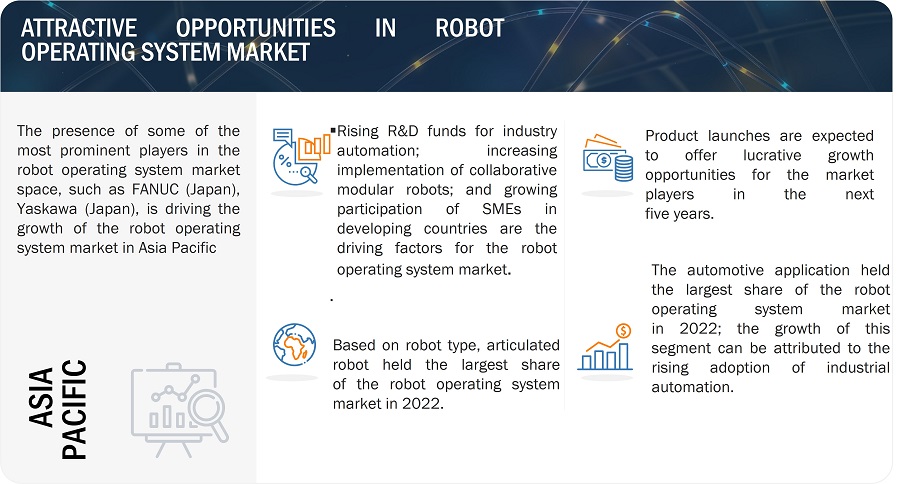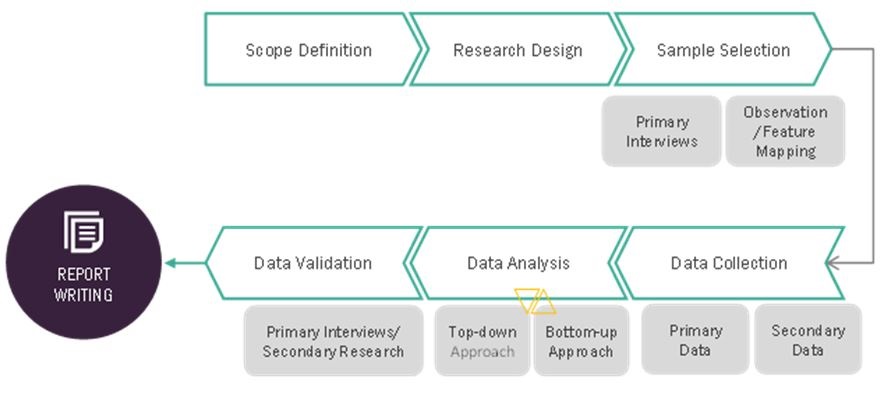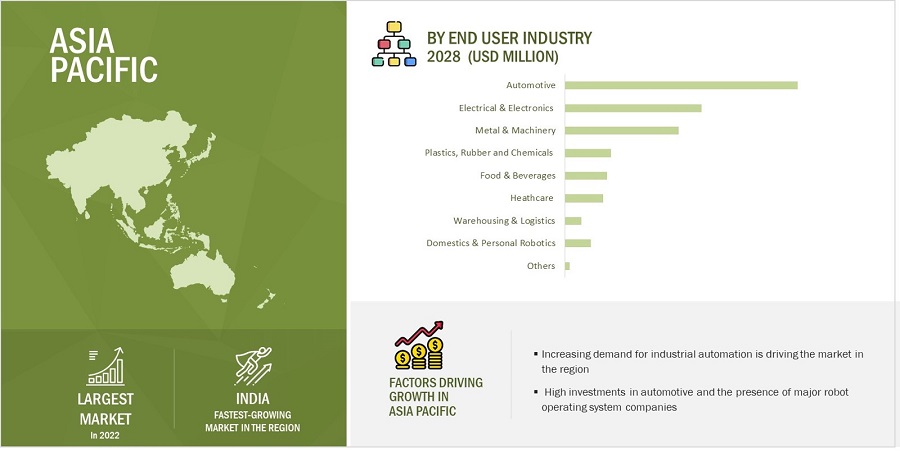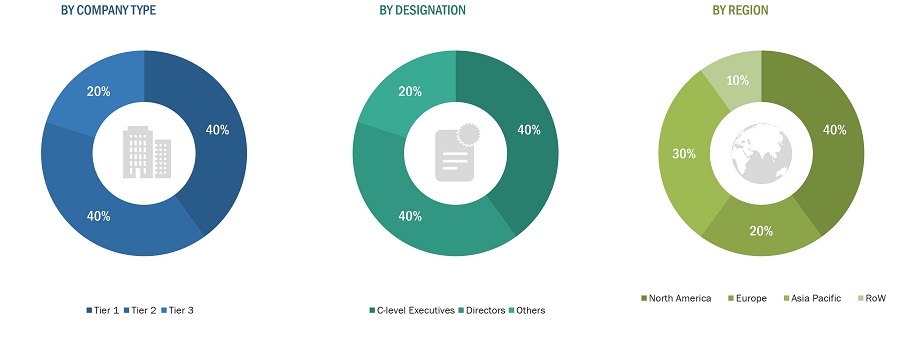Robot Operating System Market by Robot Type (Articulated, SCARA, Cartesian, Collaborative, Autonomous Mobile, Parallel), Application (Pick & Place, Testing & Quality Inspection, Inventory Management), End User and Region - Global Forecast to 2028
[250 Pages Report] The global robot Operating System market size is valued at USD 581 million in 2023 and is projected to reach USD 1,082 million by 2028, growing at a CAGR of 13.2% from 2023 to 2028. The increasing adoption of robot operating system in the automotive industry, are among factors that contribute to the growth of the market.


Robot Operating System Market Forecast to 2028
To know about the assumptions considered for the study, Request for Free Sample Report
Robot Operating System Market Dynamics
Drivers: Rising R&D fund for industrial automation
The market’s top robot operating system providers, such as ABB (Switzerland), Clearpath Robotics (Canada), Omron Corporation (Japan),Kuka AG (Germany) among others, are continuously investing in R&D activities to balance out the supply-demand chain. To improve the quality of robots as well as develop better robot operating system, companies such as ABB and FANUC (Japan) are looking forward to investing in research and innovation. The strategies such as collaborations and acquisitions are assisting organizations offering robot operating system in expanding their geographic footprints. These business expansions of the major players are creating demand for robot operating system.
Restraints: High installation cost of low-volume production applications
Despite the high rate of adoption of robot operating system among SMEs, most of the SMEs follow the low-volume production scenario due to the presence of more than one production line. The robot operating system is an inevitable process that modifies or reconfigures industrial robots, as it is designed as per the requirements of applications. The cost of reconfiguration and reinstallation of robotic systems is high for low- volume production.
Opportunity: Increasing demand for Robotics-as-a-Service (RaaS) Model
The Robotics-as-a-Service (RaaS) model can meet the growing demand for automation across several startups and multiple cost-sensitive industries, leading to the increasing adoption rate of the RaaS model across the ROS market. It enables robot operating system providers to lease their solutions to their customers in 2 ways: robotics-as-a-cloud service or on rental. The data captured by robots across different locations can be stacked in a centrally stored cloud-based system and accessed by humans. The RaaS model would ensure seamless data and process flow, without disrupting the existing businesses. Moreover, it would add value to organizations operating many robots, with each robot performing different tasks. On the contrary, businesses that find it difficult to invest in robots leverage the power of robotics by renting robots and subscribing to the shared software model. Manufacturing is one of the leading industries wherein new technologies, such as Internet of Things (IoT), are adopted during predictive maintenance. The RaaS model would be used to manage manual, mundane, repetitive, and hazardous tasks across multiple locations in various industries.
Challenges: Need to safely handle industrial grade operation
Robot operating system is being used in several industrial and service applications. The robot operating system market is growing at a rapid pace, owing to technological advancements and the integration of automation tools. The applications of robotics have been increasing, from automotive, packaging, distribution, and metalworking to inspection, mobile platforms, and human-machine interaction. However, making industrial robots safe for routine interaction with humans has been a major technological challenge, which the robotics industry has been facing for a long time.
Robot Operating System Market Map:

Autonomous Mobile robots to record a highest CAGR during the forecast period.
Autonomous mobile robots (AMRs) are robotic systems that have the capacity of navigating and operating in changing environments without constant human intervention. These robots are equipped with sensors, perception capabilities, and decision-making algorithms that enable them to perceive and interpret their surroundings, plan their actions, and navigate autonomously to perform tasks. Robot operating system is widely used in the development of autonomous mobile robots due to its flexibility, modularity, and extensive set of tools and libraries. Few of the applications of robot operating system in autonomous mobile robots are sensing and perception, location and mapping, communication and coordination, simulation and testing among others.
Healthcare segment to showcase significant market growth during the forecast period.
Robot operating system in healthcare provides a common and open system with which hospitals can interconnect, monitor, command, and simulate thousands of robots and other devices, which are already being used in modern hospitals. Robotics improve operational efficiencies by taking over administrative or repetitive clinical tasks, such as monitoring patient vital statistics and logging patient data into the Electronic Health Record (EHR) and surgical precision.As the demand for new drugs and medicines is growing, pharmaceutical companies are continuously looking for new ways to increase productivity, leading to an increased reliance on automated equipment and robotics.
Robot operating system market in Asia Pacific estimated to grow at the fastest rate during the forecast period.
Asia Pacific is expected to have highest CAGR during the forecast period. The rising costs of labor in the Asia Pacific region caused SME industries to start integrating robots in their manufacturing processes to make operations more efficient and cost-effective, hence increase in growth rate during the forecast period.

Robot Operating System Market by Region
To know about the assumptions considered for the study, download the pdf brochure
Key Market Players
In the robot operating system companies, key and emerging market players include ABB Ltd. (Switzerland), FANUC (Japan), KUKA AG (Germany), Yaskawa Electric Corporation (Japan), Denso (Japan), Microsoft (US), Omron Corporation (Japan), Universal Robotics (Denmark), Clearpath Robots (Canada), iRobot Corporation (US).
Get online access to the report on the World's First Market Intelligence Cloud
- Easy to Download Historical Data & Forecast Numbers
- Company Analysis Dashboard for high growth potential opportunities
- Research Analyst Access for customization & queries
- Competitor Analysis with Interactive dashboard
- Latest News, Updates & Trend analysis
Request Sample Scope of the Report
Get online access to the report on the World's First Market Intelligence Cloud
- Easy to Download Historical Data & Forecast Numbers
- Company Analysis Dashboard for high growth potential opportunities
- Research Analyst Access for customization & queries
- Competitor Analysis with Interactive dashboard
- Latest News, Updates & Trend analysis
|
Report Metric |
Details |
| Estimated Value | USD 581 million in 2023 |
| Projected Value | USD 1,082 million by 2028 |
| Growth Rate | CAGR of 13.2% |
|
Market size available for years |
2019—2028 |
|
Base year |
2022 |
|
Forecast period |
2023—2028 |
|
Forecast Unit |
Thousand/Million/Billion |
|
Segments covered |
Robot type, integration with other operating systems, application, end user industry and region |
|
Geographic regions covered |
North America , Europe, Asia Pacific, and RoW |
|
Companies covered |
ABB Ltd. (Switzerland), FANUC (Japan), KUKA AG (Germany), Yaskawa Electric Corporation (Japan), Denso (Japan), Microsoft (US), Omron Corporation (Japan), Universal Robotics (Denmark), Clearpath Robots (Canada), iRobot Corporation (US), Apart from these, Pal Robotics (Spain), Robotnik (Spain), Rethink Robotics (Germany), Stanley Innovation (US), Husarion (Poland), Neobotix (Germany), Shadow Robot (UK), Yamaha Motor (Japan), Estun Automation (China), Shibaura Machine (Japan), Hirata Corporation (Japan), Techman Robot (Taiwan), Franka Emika (Germany), Bosch Rexroth AG (Germany), and Kawasaki Heavy Industries (Japan) |
Robot Operating System Market Highlights
This research report categorizes the market based on robot type, integration with other operating systems, application, end-user industry, and region.
|
Segment |
Subsegment |
|
Integration With Other Operating Systems |
|
|
Based On Robot Type: |
|
|
Based On Application |
|
|
Based On the End-User Industry: |
|
|
Based On Region: |
|
Recent Developments
- In March 2023, Clearpath Robotics has launched Husky Observer™, a fully integrated system designed to accelerate inspection solutions. This new configuration of the Husky will enable robotics developers and technology groups to build their inspection solutions and fast track their system development. It is fully supported in robot operating systems, and the robot can be used to program complex autonomous systems.
- In March 2022, FANUC introduced the new CRX-5iA, CRX-20iA/L and CRX-25iA collaborative robots. The latest CRX cobots complement FANUC’s existing line of CR and CRX cobots that now comprises 11 cobot model variations to handle products from 4 to 35 kg.
Frequently Asked Questions (FAQ):
What are the key strategies adopted by key companies in the robot operating system market?
Product launches, acquisitions, and collaborations have been and continue to be some of the major strategies adopted by the key players to grow in the market.
What region dominates the robot operating system market?
The Asia Pacific region will dominate the market.
What end-user industry dominates the robot operating system market?
Automotive are expected to dominate the market.
Which robot type dominates the robot operating system market?
Articulated robots are expected to have the largest market size during the forecast period.
Who are the major companies in the robot operating system market?
ABB Ltd. (Switzerland), FANUC (Japan), KUKA AG (Germany), Yaskawa Electric Corporation (Japan), Denso (Japan),
To speak to our analyst for a discussion on the above findings, click Speak to Analyst
The study involved four major activities in estimating the size of the robot operating system market. Exhaustive secondary research was done to collect information on the market, peer, and parent markets. The next step was to validate these findings, assumptions, and sizing with industry experts across value chains through primary research. The bottom-up approach was employed to estimate the overall market size. After that, market breakdown and data triangulation were used to estimate the market size of segments and subsegments.
Secondary Research
In the secondary research process, various sources were used to identify and collect information important for this study. These include annual reports, press releases & investor presentations of companies, white papers, technology journals, certified publications, articles by recognized authors, directories, and databases.
Secondary research was mainly used to obtain key information about the supply chain of the industry, the total pool of market players, the classification of the market according to industry trends to the bottom-most level, regional markets, and key developments from the market and technology-oriented perspectives.
Primary research was also conducted to identify the segmentation types, key players, competitive landscape, and key market dynamics, such as drivers, restraints, opportunities, challenges, and industry trends, along with key strategies adopted by players in the robot operating system market. Extensive qualitative and quantitative analyses were performed on the complete market engineering process to list key information and insights throughout the report.
Primary Research
Extensive primary research has been conducted after acquiring knowledge about the robot operating system market scenario through secondary research. Several primary interviews have been conducted with experts from the demand (end users) and supply side (robot operating system providers) across four major geographic regions: North America, Europe, Asia Pacific, and RoW. Approximately 80% and 20% of the primary interviews have been conducted from the supply and demand side, respectively. These primary data have been collected through questionnaires, emails, and telephonic interviews.

To know about the assumptions considered for the study, download the pdf brochure
Market Size Estimation
In the complete market engineering process, both top-down and bottom-up approaches were implemented, along with several data triangulation methods, to estimate and validate the size of the robot operating system market and various other dependent submarkets. Key players in the market were identified through secondary research, and their market share in the respective regions was determined through primary and secondary research. This entire research methodology included the study of annual and financial reports of the top players, as well as interviews with experts (such as CEOs, VPs, directors, and marketing executives) for key insights (quantitative and qualitative).
All percentage shares, splits, and breakdowns were determined using secondary sources and verified through primary sources. All the possible parameters that affect the markets covered in this research study were accounted for, viewed in detail, verified through primary research, and analyzed to obtain the final quantitative and qualitative data. This data was consolidated and supplemented with detailed inputs and analysis from MarketsandMarkets and presented in this report.
Robot Operating System Market: Bottom-Up Approach

Data Triangulation
After arriving at the overall market size from the market size estimation process, as explained above, the total market has been split into several segments and subsegments. To complete the overall market engineering process and arrive at the exact statistics for all segments and subsegments, market breakdown and data triangulation procedures have been employed, wherever applicable. The data have been triangulated by studying various factors and trends from both the demand and supply sides. Along with this, the market has been validated using top-down and bottom-up approaches.
Market Definition
The robot operating system is a flexible and collaborative open-source software development framework. It is a special framework that was initially developed by the Stanford AI Laboratory in 2007 for developing robots. ROS provides tools, libraries, and conventions to simplify the creation of complex and robust robot functionalities across various robotic platforms.
The robot operating system acts as a robotic middleware that runs on different operating systems, such as Linux and Windows, which is a typical software platform for developers to build a robot. ROS is not an operating system but an open-source framework that provides hardware abstraction, low-level device control, implementation of commonly used functionalities, message-passing between processes, and package management.
Key Stakeholders
- Original Equipment Manufacturers (OEMs)
- OEM technology solution providers
- Research institutes
- Market research and consulting firms
- Forums, alliances, and associations
- Technology investors
- Governments and financial institutions
- Analysts and strategic business planners
- End users who want to know more about the technology and the latest technological developments in the industry.
Report Objectives
- To describe, segment, and forecast the robot operating system market based on robot type, application, industry, and region in terms of value.
- To describe and forecast the market for four key regions: North America, Europe, Asia Pacific, and the Rest of the World (RoW), in terms of value.
- To provide detailed information regarding drivers, restraints, opportunities, and challenges influencing the growth of the robot operating system market
- To provide a detailed overview of the supply chain and ecosystem pertaining to the robot operating system, along with the average selling prices of the robot operating system
- To strategically analyze the ecosystem, tariffs and regulations, patent landscape, trade landscape, and case studies about the market under study
- To strategically analyze micromarkets1 about individual growth trends, prospects, and contributions to the overall market
- To analyze opportunities in the market for stakeholders and provide a competitive landscape of the market.
- To analyze competitive developments such as product launches and developments, expansions, partnerships, collaborations, contracts, and mergers and acquisitions in the robot operating system market
- To strategically profile the key players in the robot operating system market and comprehensively analyze their market ranking and core competencies2.
Available Customizations
With the given market data, MarketsandMarkets offers customizations according to the company’s specific needs. The following customization options are available for the report:
Company Information
- Detailed analysis and profiling of additional market players (up to 5)












Growth opportunities and latent adjacency in Robot Operating System Market